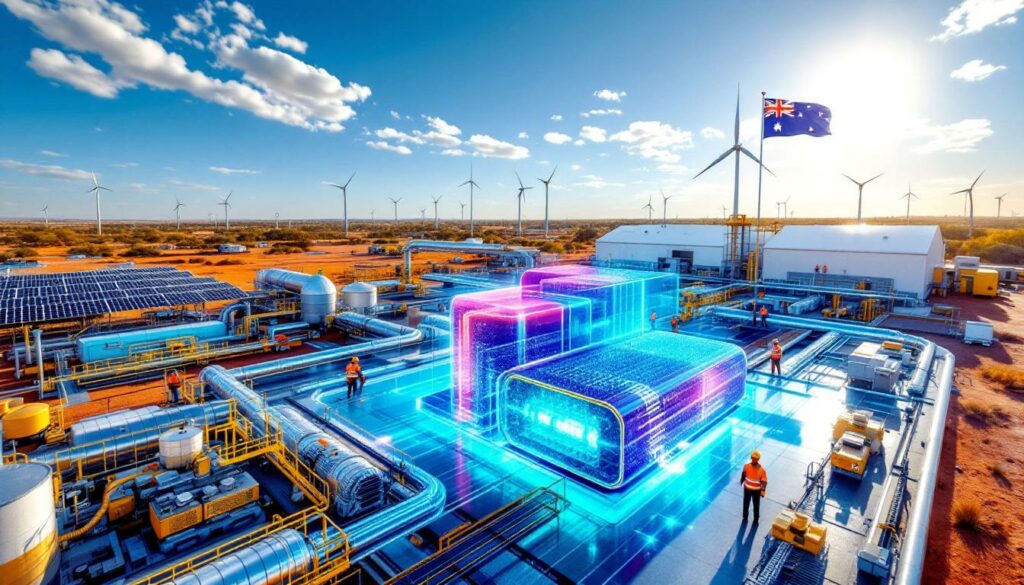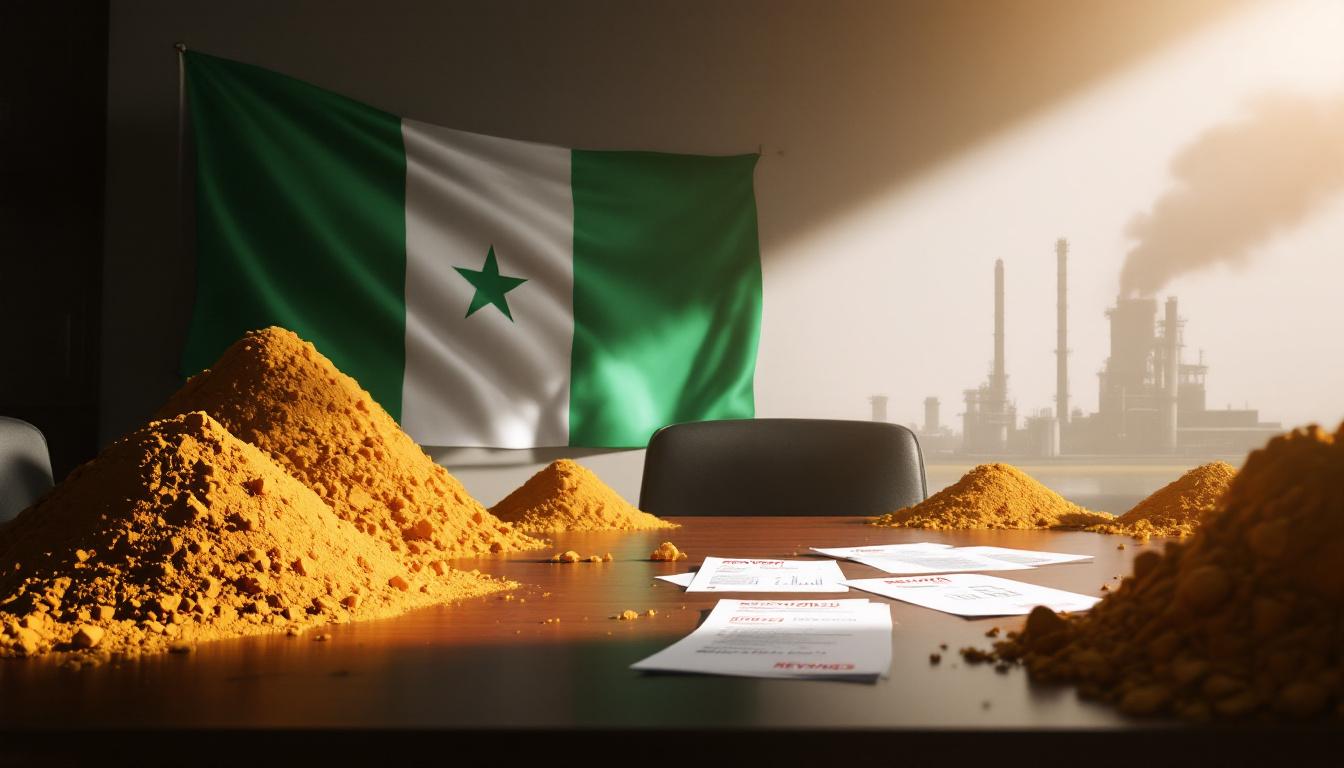WAPC Approval of AVL's Vanadium Processing Hub: A Major Milestone
The Western Australian Planning Commission (WAPC) has granted development approval for Australian Vanadium Limited's (AVL) processing facility at Tenindewa, marking a crucial advancement in Australia's critical minerals sector. This regulatory milestone enables AVL to progress its vision of establishing a fully integrated vanadium supply chain within Western Australia, strengthening the nation's position in the global critical minerals transition.
What is the Australian Vanadium Project?
The Australian Vanadium Project represents a comprehensive approach to developing Australia's first fully integrated vanadium supply chain. This strategic initiative encompasses multiple components strategically positioned across Western Australia to maximize operational efficiency and market responsiveness.
At its core, the project features a mine and concentrator facility at Gabanintha near Meekatharra, where high-grade vanadium ore will be extracted and initially processed. The newly approved processing facility at Tenindewa, approximately 65km east of Geraldton, will serve as the project's conversion hub, transforming vanadium concentrate into finished products suitable for various applications. Complementing these assets is an operational vanadium electrolyte manufacturing plant in Perth, which produces the specialized electrolyte solutions required for vanadium flow batteries.
Strategic Importance for Australia's Critical Minerals Sector
This vertically integrated project directly aligns with Australia's broader economic and strategic objectives, particularly the Federal Government's Critical Minerals Strategy and the Future Made in Australia plan. These initiatives aim to strengthen domestic production capabilities, reduce dependence on imported materials, and establish Australia as a key player in the global critical minerals reserve.
The development holds particular significance in the context of growing international competition for critical mineral resources. By establishing domestic processing capabilities, Australia can move beyond being merely a supplier of raw materials to becoming a producer of value-added products essential for modern technologies and the energy transition.
"The Australian Vanadium Project represents a prime example of how Australia can leverage its natural resources to create sophisticated, technology-enabled industries that serve both domestic and international markets," notes Graham Arvidson, CEO of Australian Vanadium.
What Does the WAPC Approval Mean for AVL?
The Western Australian Planning Commission's approval of AVL's development application for the Tenindewa processing facility represents a pivotal advancement in the company's strategic roadmap. This regulatory milestone follows a comprehensive assessment conducted by the Significant Development Assessment Unit of the Department of Planning, Lands and Heritage, which recommended approval with specific conditions.
Significance of the Development Application Approval
The WAPC approval significantly de-risks the project by addressing one of the major regulatory hurdles in the development pathway. This achievement validates the project's design, planned operational parameters, and compatibility with regional planning objectives.
According to Graham Arvidson, CEO of Australian Vanadium, "This is a landmark moment for AVL and a significant step forward in realizing our vision of a homegrown, fully integrated vanadium value chain."
The approval process involved detailed assessment of various aspects, including:
- Environmental considerations and mitigation strategies
- Land use compatibility with surrounding areas
- Infrastructure requirements and integration
- Community impact and engagement
- Alignment with state development priorities
Enabling Complete Domestic Vanadium Production
With this approval secured, Australian Vanadium can progress toward its vision of producing vanadium products, manufacturing electrolyte, and supporting vanadium flow battery (VFB) deployment entirely within Western Australia. This vertical integration capability represents a significant competitive advantage and contributes to supply chain resilience.
The domestic production capability holds particular importance given the classification of vanadium as a critical mineral by both Australian and international authorities. By controlling the entire value chain from mining through processing to end-product manufacturing, AVL will be positioned to:
- Reduce vulnerability to international supply disruptions
- Maintain quality control throughout the production process
- Optimize operational efficiency through integrated logistics
- Respond rapidly to market demands for various vanadium products
- Contribute to Australia's advanced manufacturing capabilities
How Will the Tenindewa Processing Facility Function?
The Tenindewa processing facility represents the technological heart of AVL's integrated vanadium supply chain, transforming raw materials into high-value products for both traditional and emerging markets.
Technical Capabilities and Production Potential
The facility will employ specialized processing technologies to convert vanadium concentrate from the Gabanintha mine into various commercial products. While specific production capacity figures have not been publicly disclosed, the facility is designed to process substantial quantities of vanadium concentrate to meet both domestic and potential export demands.
The processing operation typically involves several stages:
- Initial preparation and roasting of vanadium concentrate
- Leaching and purification to isolate vanadium compounds
- Chemical conversion to produce various vanadium products
- Quality control and testing to ensure product specifications
- Packaging and distribution to end users or further manufacturing
The facility's location approximately 65km east of Geraldton provides strategic advantages, including access to transportation infrastructure, proximity to port facilities for potential export operations, and reasonable distance from the mine site to optimize logistics.
Environmental and Operational Considerations
Modern processing facilities like the one planned for Tenindewa typically incorporate advanced technologies to minimize environmental footprint while maximizing operational efficiency. While specific details about the facility's environmental management systems have not been comprehensively disclosed, the approval process would have assessed various aspects, including:
- Water management: Recycling and conservation systems to minimize consumption
- Energy efficiency: Optimization of power usage and potential for renewable energy integration
- Emissions control: Technologies to reduce air emissions and maintain compliance with regulatory standards
- Waste management: Systems for responsible handling and disposal of process residues
- Noise mitigation: Measures to minimize operational noise impacts on surrounding areas
The facility's design likely incorporates the principles of sustainable development, balancing economic objectives with environmental responsibility and social considerations. This approach aligns with growing expectations from investors, customers, and regulatory authorities regarding responsible resource development.
What Economic Benefits Will the Project Deliver?
The Australian Vanadium Project represents a significant economic development opportunity for Western Australia, with benefits extending across multiple sectors and geographic areas.
Regional Development and Job Creation
According to Graham Arvidson, CEO of Australian Vanadium, "The Tenindewa processing facility will bring long-term economic and social benefits to the Midwest, including job creation, regional investment and new opportunities across the critical minerals and renewable energy sectors."
The project is expected to generate employment opportunities across various skill levels and disciplines, including:
- Construction phase jobs: Engineering, trades, project management, and support roles
- Operational roles: Process technicians, metallurgists, maintenance personnel, and laboratory staff
- Professional positions: Management, administration, finance, and technical specialists
- Indirect employment: Supply chain, logistics, services, and community support functions
Beyond direct employment, the project will stimulate economic activity through local procurement of goods and services, supporting businesses throughout the region. This multiplier effect amplifies the economic impact, creating additional opportunities beyond those directly associated with the project.
Strengthening Australia's Position in Critical Minerals
By establishing domestic processing capabilities for vanadium, the project contributes to Australia's strategic goal of moving up the value chain in critical minerals processing rather than simply exporting raw materials. This approach maximizes economic returns and creates more sustainable, knowledge-intensive employment opportunities.
The economic benefits extend to several dimensions:
- Value addition: Processing raw materials domestically captures additional economic value compared to exporting unprocessed resources
- Knowledge development: Building expertise in advanced processing technologies enhances Australia's human capital
- Technology transfer: Creating opportunities for innovation and development of proprietary technologies
- Industry diversification: Reducing economic dependence on traditional resource exports
- Market positioning: Establishing Australia as a reliable supplier of processed critical minerals
This strengthened position in the critical minerals value chain aligns with national economic priorities and supports the transition toward a more diverse, technology-enabled industrial base.
What is Vanadium's Role in the Energy Transition?
Vanadium represents a crucial element in the global transition toward renewable energy systems, with applications spanning from traditional industrial uses to cutting-edge energy storage technologies.
Applications in Energy Storage Technology
Vanadium plays a pivotal role in the renewable energy landscape, particularly through vanadium flow batteries (VFBs). These sophisticated energy storage systems offer distinct advantages for grid-scale applications, including:
- Exceptional longevity: VFBs can operate for 20+ years with minimal capacity degradation, outlasting most other battery technologies
- Unlimited cycling: The ability to charge and discharge repeatedly without significant degradation
- Scalable design: Power and energy capacity can be scaled independently to match specific requirements
- Non-flammability: Aqueous electrolyte solutions eliminate fire risks associated with some battery technologies
- Deep discharge capability: VFBs can be discharged to 0% without damage, unlike many other battery types
- Fast response time: Ability to quickly respond to grid demands, supporting frequency regulation
- Temperature tolerance: Operation across a wide temperature range without requiring extensive cooling systems
These characteristics make VFBs particularly suitable for integrating intermittent renewable energy sources into electrical grids, addressing one of the fundamental challenges in transitioning to cleaner energy systems.
Strategic Importance for Energy Security
The development of domestic vanadium production and processing capabilities supports Australia's energy security objectives by reducing dependence on imported energy storage technologies and materials. This self-sufficiency becomes increasingly important as the country accelerates its transition toward renewable energy sources.
Vanadium's role extends beyond batteries to include:
"The versatility of vanadium makes it a truly strategic material for the 21st century, supporting both traditional industries and emerging clean energy technologies."
- Steel strengthening: As an alloying element, vanadium significantly enhances steel strength while reducing weight, supporting more efficient infrastructure development
- Aerospace applications: Critical component in titanium alloys used in aerospace applications
- Chemical catalysts: Vanadium compounds serve as catalysts in various industrial processes
- Emerging technologies: Research continues into new applications in areas such as hydrogen storage and next-generation electronics
This multi-faceted utility enhances vanadium's strategic importance and provides market diversification for producers.
What Next Steps Will AVL Take?
With the WAPC approval representing a significant milestone, Australian Vanadium now faces several critical next phases in advancing the project toward implementation.
Regulatory and Development Pathway
According to Graham Arvidson, CEO: "With development approval now in place, AVL will progress secondary approvals, advance detailed engineering and continue project planning activities to support future investment and execution decisions."
These next steps include:
- Secondary permits and approvals: Securing additional regulatory clearances from various agencies covering specific operational aspects
- Detailed engineering design: Advancing from conceptual and preliminary designs to comprehensive engineering specifications
- Procurement planning: Developing strategies for equipment and materials acquisition
- Contractor engagement: Identifying and qualifying potential construction and service providers
- Financial structuring: Refining capital requirements and funding strategies
- Risk mitigation planning: Developing comprehensive approaches to manage project execution risks
Each of these workstreams represents a critical component in preparing the project for final investment decision and subsequent implementation.
Timeline for Implementation
While specific timelines for construction and commissioning have not been publicly detailed, the approval represents a significant de-risking of the project. The company will likely provide updated implementation schedules as it progresses through the remaining regulatory requirements and finalizes engineering designs.
Typical development sequences for projects of this nature involve:
- Pre-construction activities: Site preparation, infrastructure development, and early works (6-12 months)
- Construction phase: Building of processing facilities and supporting infrastructure (12-24 months)
- Commissioning: Systematic testing and startup of processing systems (3-6 months)
- Ramp-up: Gradual increase to full production capacity (6-12 months)
The actual timeline will depend on various factors, including financing arrangements, equipment delivery schedules, contractor availability, and any unforeseen challenges encountered during implementation.
How Does This Project Compare to Other Vanadium Developments?
The Australian Vanadium Project exhibits several distinctive characteristics that position it uniquely within the global landscape of vanadium developments.
Competitive Positioning in the Global Market
The project's integrated approach distinguishes it from many other vanadium developments globally, which often focus on either mining or processing rather than the entire value chain. This integration potentially offers operational efficiencies, quality control advantages, and reduced exposure to market fluctuations in intermediate products.
Key differentiating factors include:
- Vertical integration: Controlling the entire production chain from mining to end products
- Domestic market focus: Targeting Australian markets for both traditional and emerging applications
- Dual-market strategy: Serving both established steel industries and emerging energy storage sectors
- Strategic location: Proximity to Asian markets combined with domestic processing capabilities
- Government recognition: Support through designation as a "green energy major project"
These characteristics collectively contribute to the project's strategic positioning in an increasingly competitive global landscape.
Technological Differentiation
By incorporating both traditional vanadium production for steel applications and advanced processing for energy storage applications, the project positions AVL to serve multiple market segments. This diversification strategy may provide resilience against market volatility in any single application area.
The project incorporates several technological approaches that enhance its competitive position:
- Optimized processing flowsheet: Developed through extensive metallurgical testing to maximize recovery and product quality
- Multi-product capability: Flexibility to produce various vanadium products based on market demands
- Energy storage focus: Specialized capabilities for producing battery-grade materials
- Research partnerships: Collaboration with academic and industry partners to advance processing technologies
- Sustainability focus: Incorporation of efficiency and environmental performance considerations in facility design
This technological foundation supports the project's ability to adapt to evolving market conditions and customer requirements.
What Recognition Has the Project Received?
The Australian Vanadium Project has garnered significant recognition from various authorities, reflecting its strategic importance and alignment with broader policy objectives.
Green Energy Major Project Status
In January 2025, the Western Australian Government granted the Australian Vanadium Project "green energy major project status," recognizing its potential contribution to domestic vanadium production and energy storage solutions. This designation acknowledges the project's strategic alignment with Western Australia's clean energy transition objectives.
This recognition provides several potential advantages:
- Coordinated government support: Streamlined interactions with various regulatory agencies
- Enhanced project visibility: Higher profile among investors and potential partners
- Access to resources: Potential prioritization for government assistance programs
- Market positioning: Validation of the project's green credentials for environmentally conscious customers
- Stakeholder confidence: External validation of the project's strategic importance
The designation represents significant acknowledgment of the project's potential contribution to Western Australia's economic and environmental objectives.
Industry and Government Support
The project's progression through regulatory approvals and its recognition by government authorities indicate strong institutional support. This backing enhances the project's credibility and potentially improves its access to resources, expertise, and collaborative opportunities.
Support has manifested in various forms, including:
- Regulatory cooperation: Constructive engagement throughout the approval process
- Recognition in policy frameworks: Acknowledgment in critical minerals and energy transition strategies
- Industry partnerships: Collaboration with various stakeholders across the vanadium value chain
- Knowledge sharing: Participation in industry forums and development initiatives
This multi-faceted support contributes to the project's development momentum and potential for successful implementation.
FAQs About AVL's Vanadium Processing Hub
What are vanadium flow batteries (VFBs) and why are they important?
Vanadium flow batteries represent an advanced energy storage technology that uses vanadium in different oxidation states to store and release energy. Unlike conventional batteries, VFBs store energy in liquid electrolyte solutions contained in separate tanks, allowing for independent scaling of power and energy capacity.
Key advantages include:
- Exceptional cycle life: Can operate for 20+ years with minimal degradation
- Scalability: Independent sizing of power and energy components
- Safety: Non-flammable aqueous electrolyte
- Deep discharge capability: Can be fully discharged without damage
- Rapid response: Fast reaction to demand changes
- Recyclability: Electrolyte can be reused at end of battery life
These characteristics make VFBs particularly valuable for applications requiring long-duration storage, frequent cycling, and high reliability, such as grid stabilization and renewable energy integration.
How does domestic vanadium production benefit Australia's economy?
Establishing domestic vanadium production creates multiple economic benefits, including:
- Job creation: Employment opportunities across mining, processing, manufacturing, and technology sectors
- Value addition: Capturing greater economic value compared to exporting raw materials
- Supply chain security: Reducing dependence on imports for critical materials
- Knowledge development: Building expertise in advanced processing and battery technologies
- Export potential: Opportunities for exporting finished products and technical knowledge
- Industry diversification: Expanding beyond traditional resource sectors
- Regional development: Investment in rural and regional communities
- Technology leadership: Positioning Australia at the forefront of energy storage solutions
Additionally, it supports the growth of related industries such as renewable energy and advanced manufacturing, creating a multiplier effect throughout the economy.
What environmental considerations are associated with vanadium processing?
Vanadium processing, like other metallurgical operations, involves several environmental considerations that must be carefully managed:
- Energy consumption: Processing operations require significant energy inputs, necessitating efficiency measures and potential renewable energy integration
- Water management: Systems for water conservation, treatment, and recycling to minimize consumption and prevent contamination
- Air emissions: Control technologies to manage particulates and other potential air pollutants
- Waste handling:
Ready to Catch the Next Major ASX Mineral Discovery?
Don't miss out on potential investment opportunities in the mining sector. Discover how Discovery Alert's proprietary Discovery IQ model instantly identifies significant ASX mineral discoveries, transforming complex data into actionable insights at https://discoveryalert.com.au/discoveries/.




